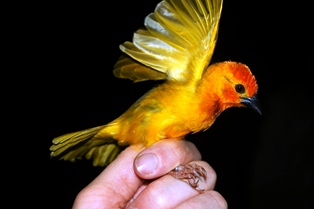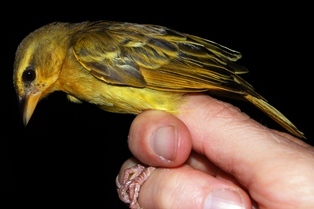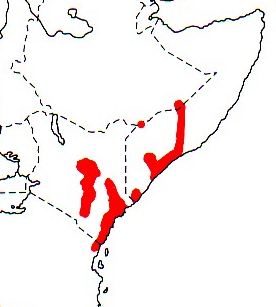Weaver Wednesday [45]: Golden Palm Weaver 2013-04-24 (357)
 Weaver Wednesday
Weaver Wednesday


The Golden Palm Weaver Ploceus bojeri is a common weaver of the coastal palms in East Africa. The black eye is in striking contrast to the orange (male) or yellow (female) head. The adult male has the head uniform orange, shading to a chestnut patch on the lower throat - in the similar male Eastern Golden Weaver P. subaureus the orange face pales onto the ear-coverts and sides of the neck. The Golden Palm Weaver shows no seasonal change in plumage. The subadult male has a yellow head with developing orange on the nape and lower throat - the similar Taveta Golden Weaver P. castaneiceps differs in having a well-defined occipital crescent and rufous upper breast, and their ranges do not overlap. The female Golden Palm Weaver is entirely yellow below (thefemale Eastern Golden has a white belly) and the back is indistinctly streaked (heavily streaked in Taveta Golden Weaver).

No subspecies of the Golden Palm Weaver are recognised (see map right, based on Birds of Africa). There are few records from Ethiopia, near the border with Somalia. In Somalia, it occurs on the Jubba and Shabeele Rivers and in Boni Forest. In Kenya it is found on the coast and inland along the Tana River, with a separate localized inland population. Records from Tanzania are now considered misidentifications and the species has been deleted from the Tanzanian list.
The Golden Palm Weaver inhabits palm savanna on the coast, as well as riverine habitats and it extends into savanna in areas below 1200 m and with more than 500 mm annual rainfall inland. Food consists of seeds and insects. It is gregarious and roosts in flocks when not breeding.

The Golden Palm Weaver is colonial, and suspected to be polygynous. It may occur in mixed colonies with Eastern Golden Weavers or with Village Weavers P. cucullatus. The male displays while hanging below the nest entrance, with his wings spread vertically, but wings usually move very little; the head may be bowed slowly.

The nest is spherical with no entrance tube. The male weaves the outer shell of long grass strips or strips from palm fronds and builds a complete inner shell of short grass strips. The female lines accepted nests with leaf fragments and fine grass heads. Nests are usually suspended under palm fronds or over water in thorn trees.

Clutch size is 2. The eggs are green, mottled with grey or reddish markings; sometimes eggs are white, overlaid with fawn. The introduced House Crow Corvus splendens raids colonies for eggs, young and adults in Mombasa.
The Golden Palm Weaver has 4 PHOWN records from Kenya and two of these colonies low nest counts - 1 and 10 nests. Many more PHOWN records are needed for this species (see PHOWN summary), especially to determine range in colony size. Submit any weaver nest records to PHOWN (PHOtos of Weaver Nests) via the Virtual Museum upload site.
PHOWN summary
Previous Wedn: Speke's Weaver
Full weaver species list
| 

 Weaver Watch
Weaver Watch


